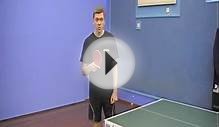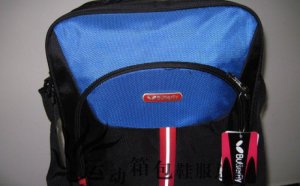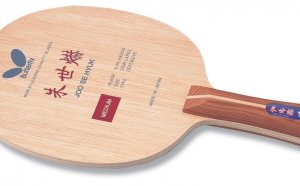
Most expensive Table Tennis Racket
What is most important about the racket is that it feels "right" for you. If you try the rackets of others, you will quickly realize that there are different speeds of rackets. The blade is most responsible for the speed of your racket, and since it is not a wear-and-tear item, it is most important to get right. The rubber, which influences more the trajectory of the ball, the spin, and the bounce at touch, is replaceable and more easily swapped if you need to try a few to explore.
My suggestion is to look at the racket you are using now, and try the rackets of a few other people. You should be able to feel which ones are too fast, too slow, and just right for you. Take note of what feels good. Write down the names of the rackets. Even take a side picture of the layers, such as:
Now you need to find out what kind of construction the rackets that felt good to you were. There are 5 general types of rackets used by orthodox offensive table tennis players:
- 5 ply wood
- 7 ply wood
- 3 wood + 2 composite
- 5 wood + 2 composite
- 1 ply wood
For example, the picture I included above is a 3+2. You can see a thick core, two layers of composite, and two surface wood layers. Identify how the racket you like is constructed. Pay close attention to the speed of the racket, at both soft and hard hits. A thick 3+2 and thin 5+2 may be equally fast when you are hitting as hard as possible, but the 5+2 will be much lower on touch shots, for example. This is why you cannot only go by thickness, you also need to pay attention to construction. Once you have a general idea of the construction, then identify the thickness of the racket. You may need to consult some catalogs, online websites, shops, or even measuring yourself to get this information, but I think it is worth it to know what you want.
Once you know the construction and thickness, the choices in woods, composites, handle shape, head size, etc. are all nuances. They will affect your racket in noticeable ways, but not as much as the construction type and thickness. I will leave you to the marketers at the equipment companies to sell you on which kinds of materials to choose. My suggested approach is the same - identify what you like and work from there. Another benefit to this approach is that you aren't beholden to a single company and their arbitrary ratings on their equipment. If you know construction and thickness, you can cross-shop brands easily.
As for rubber I suggest starting with new sheets of what you are using now, or something very popular. Sriver, Mark V, or even Tenergy are fine - don't let people dissuade you from using certain things just because you are new. The benefit to using something popular is that you can make adjustments more easily until you find something perfect for you. If you use something popular but find that you want a little more spin from the rubber, or something less bouncy, or whatever it may be, it will be much easier for people to suggest something for you. If you are lucky you might find one of these rubbers suitable on the first try - they're the most popular for a reason.
This all sounds very technical but I think that it's worth the effort to really find something that feels very natural to you. In my experience trying to train around a racket that is just too fast or too slow for my natural stroke is not only not optimal, but detrimental and a waste of time.
RELATED VIDEO



Share this Post
Related posts
Butterfly Table Tennis rackets
Zhang Jike Super ZLC FL Blade with Tenergy 64 2.1 Red Rubber and Tenergy 64 2.1 Black Rubber. All pro-line rackets are assembled…
Read MoreButterfly Table Tennis Racket Price
NL Hard Full Case: Hard outer shell provides excellent protection for your racket. One mesh pouch inside. Complete with carrying…
Read More










